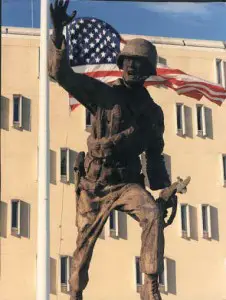Monthly Archives: May 2012
 It always gets to us a bit when people thank us on Memorial Day. Thanks are always appreciated, after all, even though our reasons for serving were personal and sufficient and absolutely no thanks are expected or required. And Memorial Day is about the fallen, not the survivors. It’s a day to eat and drink and be merry, because that’s what they’d have wanted, and that’s what we’d have wanted them to do if the ball bounced the other way and the roles were reversed. It is fitting and right.
It always gets to us a bit when people thank us on Memorial Day. Thanks are always appreciated, after all, even though our reasons for serving were personal and sufficient and absolutely no thanks are expected or required. And Memorial Day is about the fallen, not the survivors. It’s a day to eat and drink and be merry, because that’s what they’d have wanted, and that’s what we’d have wanted them to do if the ball bounced the other way and the roles were reversed. It is fitting and right.
So we hope everyone had a good day: cookout, beach, ball game, bike ride, whatever way you and your family celebrate life. Because we celebrate the dead by living in their stead — and pausing from time to time in thankful remembrance.
When old soldiers gather, they don’t get long faces when they talk about their fallen friends. They tell funny stories. They keep these souls in heart and memory on this side, for a little longer at least, at least until we all cross over to the other side. That, too, is fitting and right.
Veterans and Hollywood are often at odds. But not everybody in Hollywood is a Sean Penn, Mark Boal or Alec Baldwin who hates, smears and demeans soldiers. There’s a lot of good Americans (and good foreigners, drawn to this quintessentially American industry) there, some of them “in the closet” and some of them “out” — to steal the nomenclature of our gay friends. Some of them are celebrating the lives of the fallen today: Gary Sinise, for one, and Tom Selleck who is at the Vietnam Memorial. Funny that two men who are not Vietnam veterans became so identified with them after playing Vietnam veteran characters, but there it is (Selleck did serve in the National Guard). Sinise will be co-hosting a the National Memorial Day concert at 8PM Eastern tonight, on PBS and NPR (actor Joe Mantegna is the other co-host).
The WWII guys had John Wayne all along, it took the Vietnam dudes a while to get champions like those guys. Like the poor Vietnam throgs, it’s going to take us GWOT guys 20 years to do better than Woody Harrelson, we figure. In the meantime, we can pretend there are no movies: nobody else went to any of the last few years’Iraq or Afghanistan craptaculars, either.
The great cartoonist Chris Muir (who himself is an example of a non-vet entertainer who’s behind the guys and gals 100%) had a Sunday strip yesterday about Josh Tate’s Hell Walk. Don’t know who Josh is, but on Chris’s say-so we’ll commend him to you. (The grey-bearded character in Chris’s strip, Zed, is a retired veteran who was some kind of SF reserve officer — “I keep it vague,” Chris, a non-vet, admits, “because if I get specific I’ll get something wrong!”) Chris is a friend and we hope you’ll check out his cartoon, Day by Day.
Across the country newspapers and TV stations are running Memorial Day human interest stories, some of which are very good — we liked this tale of a family’s long wait for certainty after their relative’s AC-130 was shot down in 1970. Most of the stories, even in the papers that Yes, there are some people whose head is seriously misplaced on Memorial Day. You know where. We’ll discuss them another day. Today…. thrown another burger on the grill. You can eat salad tomorrow; today is the meat-eaters’ day. Have fun — they just might be watching and counting on you.
Thank God that Such Men Lived
A guest Memorial Day post by COL (Ret) Jack Tobin, USSF.
© 2012 Jack Tobin. Used by permission.
Yesterday, I sat beside my uncle Richard, once a big man, with a ready laugh, a humble man who loved his family, his country and the Army, in that order. No, Richard was not a retired soldier, or a Medal of Honor winner; he only spent four years in the Army: January 1942 – December 1945. One of the first to enlist after Pearl Harbor, a nineteen year old skilled mechanic, the Army wanted him to be a mechanic, for once recognizing a usable skill. But Richard would have none of it, and went Infantry, and then one of the first to be in armored infantry.
Richard and his half tracks — he was a squad leader and then platoon sergeant — went all through North Africa, Sicily, and then on to England and to France/ His unit was one of Patton’s first and best. In fact, behind the first tanks into Bastogne was a beat up halftrack with “Diamond Lil IV” on its side, named for my Aunt Lillian, then the fiancée he left behind. He survived that war, came home, married Diamond Lil, and raised three kids; worked for forty years at Goodyear, and retired to Florida.
He is now a frail man, very close to death, on oxygen. I could only spend a few hours with him, but as we exchanged war stories, at Lil’s request I emptied the cigar box she had taken from his dresser, and arranged the ribbons and badges on a pillow: his Silver Star, his Bronze Star, the Purple Heart with three clusters (he waived going home when offered after the third award), the CIB, the campaign ribbons, and marksmanship badges: the expert for his favorite weapon, the BAR, and the others.
Those ribbons will be on top of the 48 star flag he carried when he left Conshocken, PA, and brought home with him. He flew it every year on May 8.VE day. Yesterday, he told Lil. “Send the flag to Jackie when I don’t need it anymore.”
As I left, he called out “Jackie” I turned and with great effort he rose on his elbow and saluted, as I returned his salute, he laid back and said with much effort “thanks for coming, Colonel”.
One day soon, maybe tomorrow, America will lose one more soldier, and we all will be a little poorer for the passing.
Didn’t mean to bore anyone, I apologize if I did, but all the way home I thought about this, and finally realized that you should know this man died, beside his family.
Don’t mourn him, for his old boss, GEN George Patton said it best: “It is foolish and wrong to mourn these men who died. Rather we should thank God that such men lived.”
Years ago over a beer, he told me that just about all his guys were gone, and when he got to where he was going, he hoped there was a halftrack for them to get around in. I do too. -Tobin.
Sunday Best?
Sunday best be turnin’ off dat computer and goin’ to Church, if you know what’s good for you.
Back tomorrow with a Memorial Day guest post, posting may be slow Monday (Memorial Day).
And thank you all for reading and commenting! Suggestions and requests are always welcome.
That was the week that was: 2012 Week 21
Twenty-one weeks down,thirty-one to go. We continue to report and break new developments in the story, for which we thank our sources, who have been told in clear terms that talking to press or bloggers is something to do if you’re contemplating retirement, as is resisting the coming entrance of women to the Infantry school as absolute equals in everything — except, of course, meeting the standards. The standards will meet the women instead. It has ever been thus.
Comment of the Week
A strange week for comments, as most of the comments we received still come on our initial Rangerette post from two weeks ago. But we’ll go with this one, the second of two posted by the well informed Martin in the VG 1-5 thread:
Indeed the Weaver book is very good. Gives a good overview of the Volkstrum and most of the different weapons used by them.
I think you are somewhat confusing the mix of rifles used by the Volkstrum with the one’s that were Volkgewehr 1,2,3,5. These rifles were part of the national VG program. The VG5 was a Mauser that was used new parts and was a simplified. It was built with new actions & barrels. It used a standard Mauser mag.
The ones you have seen that were made of mismatched parts etc would have been rifles put together at the Gau or Kreise level for their Volkstrum . These weren’t VGs. The VG1-5(MP507) wasn’t approved at the national level either.
A friend or ours used to quip that someone, somewhere, had probably published a book, Left Handed Wingnuts of the Third Reich. And its true that once, crudely made rifles like these would not have been desired by collectors. Tempus Fugit.
Gun Stuff We Actually Did
Nothing. Again. And really, we mean it this week.
What We Blogged
This was another catch-up. But hey, we actually posted the Saturday Matinee on Saturday, isn’t that something?
Note that initially, nothing will be linked, but we’ll gradually add the links in. The stories can be found by scrolling back and using the “older stories” button, until the links turn up.
- On Sunday the good folk are in church… and the bad folk are cleaning weapons. Oh wait! We did do some of that, does that count?
- Rocketing to Jail in the Golden State is a kid who bought a surplus, inert rocket launcher, thanks to cops who have weird ideas about weapons. Maybe if you filled it with sand you could bludgeon someone with it, but that’s the extent of its utility as a weapon. And a 13-year-old is in jail over it Well, CA has to justify those sky-high cage-kicker salaries by locking folks up.
- What’s Driving the Drive for Rangerettes turns out to be, in part, Marine envy on the part of the Chief of Staff. Please, whoever picks these guys? No more tankers. Kthxbai.
- Question: are these any good? Asked about a couple of self-defense instructional materials and answered back-channel.
- Teddy Roosevelt’s Assassination Weapon was a Winchester ’94. Look for a slight update to this post this week!
- Brit Soldiers like American Idea – Stolen Valor Act. The Brits call their phonies, who outnumber their real squaddies, it seems like, “Walts”. From “The Secret Life of Walter Mitty.” With a link to the story!
- Rangerette Roundup. Links to several of our women-in-Ranger-School and Infantry links, kind of obsoleted by the “Rangers and Rangerettes” category which anyone can use to see all related stories.
- AR-15 parts vanishing from shelves, according to shoppers.
- Wednesday Weapons Website of the Week: Unblinking Eye which has a really great set of in-depth essays on mostly early 20th-Century handguns.
- Another day, another inert weapons panic. This one was over inert ‘nades.
- He brought a knife to a gun fight and it ended about as well as he could have hoped at that point. He’s in jail and when he gets out he has a free ride to his native land — one way.
- SF Weapons 1972-1992 Image No. 1. This picture of M16A1 rifles and SF ephemera, was meant to accompany the Legendary Weapons of SF series.
- Assclown Update. A plea bargain nears for serial phony and identity thief Robert McDowell.
- It’s not just Ranger School that’s getting “the feminine touch.” Women are coming to Infantry Oficers’ Basic Leadership Course, too, and may be commissioned as infantry officers.
- Gustloff “VG1-5” video from ForgottenWeapons.com
- Juxtaposition: Handling Secrets
- Know Bull? Namely, Arthur “Bull” Simons? The author of a coming Simons biography wants to hear from his former associates in the military.
- No Chute? No Problem! For British adventurer.
- Saturday Matinee: Heartbreak Ridge (1986). Clint Eastwood leads a group of misfit Marines to success in training and combat.
- That was the week that was: 2012 Week 21 – This post, which brings us full circle.
What’s Coming Next Week
Let’s see if these really happen:
- Theodore Roosevelt, Silencer User
- Ranger Fitness
- The First Semi-Auto AKs in America
Plus these leftovers from two weeks ago:
Plus these leftovers from three or more weeks ago now:
- Legendary Weapons of SF 1992-2012… to conclude the series.
- Some analysis on the ATF Weapons Statistics and the dreadful media.
- A local (NH) gun story that was incredibly badly botched (or dishonestly reported).
- A couple of book reviews.
How we did on Last Week’s Promises
We got a couple of the posts we wanted done, including more Rangerette info, and a post on Theodore Roosevelt’s around-home varmint gun, a Winchester 1894 with a Maxim silencer.
The Boring Statistics
20 posts, about 12,000 words (counting everything), and 27 substantive comments, plus about 100 more on previous weeks’ posts.
Saturday Matinee: Heartbreak Ridge (1986)
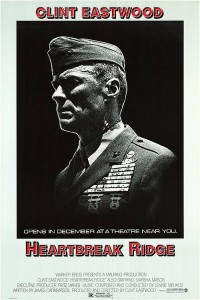 This movie had a painful gestation. Grenada was the war where the Army’s post-Vietnam fugue began to clear, but it was also the war where the Army’s post-Vietnam political correctness got started. As the war blazed, a trooper in the 82nd sent back stories to the unit’s hometown paper, the Fayetteville, NC, Observer. The Observer ran these frontline dispatches warts and all, including such things as 82nd guys commandeering a car that turned out to belong not to a Cuban general but a nominal “diplomat.” This caused military lawyers, who were beginning their long ascendancy to their current dominance of mission planning and execution, to have entire litters of kittens. Some unsanitized stories of infantry combat also hit ink, causing a flap. Infantry combat, of course, is an enterprise in which, despite the current senior staff thinking that it exists for the enhancement of officer careers, either your enemies die unpleasant deaths, or you do. Or both.
This movie had a painful gestation. Grenada was the war where the Army’s post-Vietnam fugue began to clear, but it was also the war where the Army’s post-Vietnam political correctness got started. As the war blazed, a trooper in the 82nd sent back stories to the unit’s hometown paper, the Fayetteville, NC, Observer. The Observer ran these frontline dispatches warts and all, including such things as 82nd guys commandeering a car that turned out to belong not to a Cuban general but a nominal “diplomat.” This caused military lawyers, who were beginning their long ascendancy to their current dominance of mission planning and execution, to have entire litters of kittens. Some unsanitized stories of infantry combat also hit ink, causing a flap. Infantry combat, of course, is an enterprise in which, despite the current senior staff thinking that it exists for the enhancement of officer careers, either your enemies die unpleasant deaths, or you do. Or both.
The institutional Army — the part that worries about career advancement, tidy uniforms, and white-glove inspections — had a case of the vapours worthy of the most delicate Victorian spinster to begin with, when came some Hollywood characters with the idea — and the script — for a movie about the Rangers. The Ranger battalions had been training mercilessly since the 1970s for this moment, and the Grenada operation utterly validated their mission concept even as it sent some other units back to the doctrine huddle. They adapted with American flexibility and conquered with American grit. And some producers wanted to put this on the screen, with Clint Eastwood who was currently box-office gold, and all they needed was a little support from the Army.
The Rangers loved the idea, but it wasn’t their decision — it was the Army’s PR weenies, who like PR weenies everywhere illustrate the maxim, “Those who can’t do, promote.” The weenies flaked and went to the lawyers, who got so agitated that the Pentagon shopette ran out of Vagisil. No way was the Army going to be portrayed as having an indisciplined element in the Rangers, even if the point was for tough Sergeant Highway (Eastwood) to whip them into fighting shape and lead them in battle. No way does the Army have sergeants who drink and swear. No way would the Army ever have an incompetent officer (and by this point every Army vet who’s seen the film knows the character we’re talking about, and ran into his doppelgänger more than once). And a scene in which Sergeant Highway dispatched hors d’combat Cuban troops sent the lawyers into sheer HP (old pre-PC SF term: Homosexual Panic). So the Army said no, no, no. Eastwood himself appealed up the Chain of Command, as it were, but the Army’s no was final.
The last thing the Army wanted was to be depicted as defeating the enemy through improvisation and courage. Couldn’t Eastwood make a movie about highly diverse public affairs officers* cooperating to edit a Hometown News press release or something?
Eastwood took the script to the Marines, who had one basic question: would the Marines be the good guys? Why, yes, they would be. This led to some weirdness in the script, because one of the key details in the script is how Gunny (his Marine title) Highway, Command Sergeant Major Choozhoo, and the late “Stoney” Stone MOH served together at Heartbreak Ridge — a bloody Army battle in the Korean War. The solution to the problem is that Choozhoo and Highway later left the Army and joined the Marines. (As strange as it may sound to the civilian ear, people do do this all the time. Many SF soldiers started off in the Marines, Air Force or even Navy, and we know one retired Air Force general who was enlisted in SF before going to college, but we think he keeps it on the down low with his Air Force pals).
So that’s 580 words of set up: what about the movie? Alright. First, it’s not a chick flick but it does have a romantic subplot, so you can make your LYB sit through it, but she’s going to make you watch something dreadful as a reprisal, so you probably shouldn’t. It’s a Clint Eastwood vehicle, with a fine Eastwood performance as the cranky old man we’ve seen in everything from High Plains Drifter to Gran Torino and back again, and it was directed by Eastwood also.
In this case, the kids he’s trying to get off his lawn are an undisciplined recon platoon — the usual mix of Hollywood ethnic diversity, with relatively limited characterization each to each. Highway quickly establishes himself as the alpha wolf in the pack, and the troops don’t want to admit that his unconventional methods are making them do what he wants. The oldest trick in the training book: if they hate you, it will bring them together as a team. The troops try every method of resistance imaginable, but it’s not Highway’s first rodeo, and he makes them a fighting force despite themselves. He also uses the second oldest trick in the training book: intramural competition, in this case with “Firs’ Platoon” of which a rival sergeant announces, “Me an’ the Major is buildin’ a eee-light fightin’ force.”
The Major (Everett McGill) is a perfectly drawn and played character, and a type that veterans in particular will recognize: the insecure, careerist, ring-knocking, cheating, lying self-promoter. You will spend the whole movie anticipating his comeuppance.
Sergeants may run the armed forces, but they work for officers, and Highway’s platoon leader is another well scripted, cast, and played character, Lieutenant M.R. Ring (Boyd Gaines). At first, he’s as inept as any novice lieutenant of fact or fiction, but as the film plays on, his character develops. This is another thing that will ring true for the military veteran, officer or enlisted.
Mario van Peebles plays a key supporting role as the kid with an attitude who steps up to accept Highway’s mentorship and develop, against all odds, into a Marine worthy of respect.
When the movie was done, the Marines weren’t sure they liked it, and backed away from any co-promotion, but over the years it has become a well-regarded part of the Marine film canon — even as real Marines laugh at some of the Hollywood overreach.
Several of the movie’s combat vignettes were accurate, although, given the movie’s weird genesis, most of the true stories that these celluloid Marines reenact really happened to soldiers, from the bulldozer-supported attack to the credit-card call for air support, to the liberation of the Medical School. One thing often taken as Hollywood but absolutely correct was units trying to operate with no maps or tourist maps. The poor map support plagued all services, and led to a reorganization of the agencies responsible (without, of course, any sacking of the people responsible. But map support was a little better in Panama (1989) and a lot better, if not good enough, in Somalia (1993) and Afghanistan (2001).
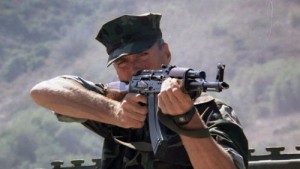 The weapons in Heartbreak Ridge are generally correct, thanks perhaps to Marine support. The MILES system is shown more or less realistically. True, the tactics and particularly the training are not what real Marines do, and the indiscipline at the beginning, and Highway’s throwback motivational techniques, are 99% Hollywood.
The weapons in Heartbreak Ridge are generally correct, thanks perhaps to Marine support. The MILES system is shown more or less realistically. True, the tactics and particularly the training are not what real Marines do, and the indiscipline at the beginning, and Highway’s throwback motivational techniques, are 99% Hollywood.
But one thing they absolutely nailed: the AK-47 is the preferred weapon of our enemies. And it does make a distinctive sound when fired at you!
*”Highly diverse public affairs officers” is a joke. They’re disproportionately blonde babes, for the same reason your TV newsreaders are.
No Chute? No Problem!
Henley-on-Thames was previously best known to us as the home of the late George Harrison (if you like his songs, check out his new posthumous album of demos and home recordings. Good stuff). But now, sleepy Henley’s down on record as the site of the world’s first deliberate jump from an aircraft to surface level without a parachute. British adventure-sportsman Gary Connery has set this record, a “first” that few imagined could even be possible.
There have been people who survived chuteless jumps before through freak accidents, and stunt men who have jumped without a parachute and intercepted one and donned it in midair, and stuntmen who have jumped from one aircraft and intercepted another and boarded again in midair. But this event, in which a wingsuit jumper went from aircraft to ground without a parachute at all, has been coming as wingsuits have gotten more effective and elite wingsuit jumpers have gotten more skilled at flying them.
Wingsuit jumper Gary Connery completes ‘no parachute’ fall over Oxfordshire – YouTube.
Connery jumped from 2,40o feet above a field that was prepared with a high stack of cardboard boxes as an energy-absorbing landing zone. His landing appears to be at about 50 or 60 mph forward speed, and his descent rate about the same as a heavily-loaded combat jumper with a round chute, about 25 feet per second, just eyeballing the video.
Connery was visibly uninjured and in a post-jump interview told ITN News [YouTube video] he was “buzzing… every little hair on my body is doing something… I’m on such a high!”
We’re interested, of course, because SF is an airborne unit that retains the capability to insert by air, and also was the original developer and first employer of combat HALO tactics. So that begs the question: does Connery’s achievement have any military application?
Answer: not at this time. You’re not going to get your enemies to build you a cardboard-box runway in their rear area, and developing Gary Connery’s level of skill is not something you can do as a part-time task while being the jack of all trades that special operations require. HALO (High Altitude Low Opening) parachuting itself is a demanding skill and time-consuming to maintain — in its military applications it’s considerably tougher than skydiving.
Now, the underlying concepts might get used to extend the current HAHO and HALO capabilities, especially if in-air navigation can be automated. Tinkerers and engineers (who are sometimes different people, and sometimes both skills in the same person) are working on it, so who knows?
Know Bull?
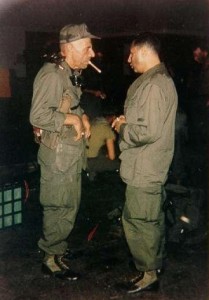
COL Arthur D. “Bull” Simons (l). Dr. Joe Cataldo (r.). Immediately before the Son Tay Raid, 1970. Image: Son Tay Raiders ass’n.
Well, do ya? The “Bull” in the title being Arthur D. “Bull” Simons.
Simons was a legendary leader of the Son Tay Raid, a near-perfectly-executed hostage rescue mission that was let down by inconsistent intelligence preparation of the battlefield. The near-perfect execution included the safe return of all members of the raiding force, and all aircraft except for one that was intentionally sacrificed in a crash landing. (Here’s a précis of the raid by Simons’s boss, USAF then-BG Leroy Manor, and here’s the comprehensive website of the veterans’ association).
Simons was squeezed out of the Army because he lacked the higher education that was deemed mandatory for an officer in the later years of his career; he was a straightforward man who excelled at combat leadership, and it was as if both of those qualities offended the officer corps’ dominant West Point culture.
After being shuffled off into retirement, Simons found work in the private sector, including a remarkable mission in which he rescued threatened Westerners from Khomeini’s Iran at the behest of their private employer, even as the US dithered and then failed in an attempt to rescue the better-known Embassy hostages.
Ironically, there have been several books about the failed Iran raid and its leader, Col. Charles Beckwith, but much less has been written about Son Tay (Schemmer’s The Raid is the definitive source) and next to nothing about Simons himself. The Arthur D. Simons Center for the Study of Interagency Cooperation, spomsored by the Command and General Staff College Foundation, would like to change that, and has commissioned a biography of their namesake, which will be written by James Willbanks, PhD.
In connection with this biography, they have recently put out the call for people who knew The Bull to come forward with their stories.
The Simons Center is calling on the public to collaborate on its new project to prepare a biography of Col. Arthur David “Bull” Simons, namesake of the Simons Center. Simons was an early member of the Special Forces, and made a lasting impact on the community. He led a mission to rescue American prisoners of war in 1970, and later freed Americans who had been imprisoned in Tehran.
The 1978 Tehran rescue was detailed in Ken Follett’s On Wings of Eagles, which was made into five-hour mini series in 1986. Yet, the full story of Simons’ life and career has remained largely untold. That is, until now.
In 2011, the Simons Center decided that the full story of Bull’s life needed telling. Enlisting the help of an author and historian at the U.S. Army Command and General Staff College, the Simons Center began researching Simons’ life, looking for family, friends, and colleagues who might be able to shed a little more light on Bull’s life and career. Several useful contacts have been established, and individuals continue to come forward, eager to share their experiences with Bull.
Gee, that sounds like they’ve got it handled. Mr Willbanks, a pro historian, is on the job, they’ve been pulling up records and talking to the (dwindling, unfortunately) veterans of Simons’s great adventures like the Son Tay Raid and the White Star Mobile Training Teams. So why a call to the public?
But the Simons Center still is interested in learning more about Bull, his life, his career, and his colleagues. If you have first-hand accounts about your service or association with Col. Simons, other personal stories, or photos that you would like to share, please contact the Simons Center. We will connect you to the author and researcher for the project.
If you are someone who has a first-hand Bull story, drop an email to [email protected] or call (913) 682-7244. Unfortunately we can’t help there -while we served with several Son Tay Raiders over the years and heard enough Bull stories to think that Mr Willbanks is going to have to work his socks off to turn his life into a dry and dull book, we never met the guy himself. Our loss.
For more information about the Bull Simons biography project, please follow the link below.
Bull Simons Book Project
via Help Tell Bull’s Story | Col. Arthur D. Simons Center.
Juxtaposition: Handling Secrets

Dr Shakil Afridi at a public-health meeting in 2010. Abandoned and exposed by attention-seeking intelligence-community leakers, he gets out of prison in 2045.
Special Operations hinge on intelligence, and intelligence sources and methods are utterly dependent on secrecy.
To use an example known to all: the Allies defeated the U-Boat menace in the Atlantic in large part because Allied cryptanalysts and engineers broke and reverse-engineered what German cryptographers and engineers were convinced was an unbreakable cryptosystem, the Enigma. Had the Ultra secret leaked to the Germans, they would certainly have revised their codes, perhaps taking the U-boats to unbreakable one-time pads.
As a rule of thumb, the closer one is to where the enemy expresses his opinion of you at about 3,000 feet per second, the more one appreciated maintaining the security of one’s sources and methods. Like that Enigma, right? So let’s juxtapose two stories.
First, meet Dr Shakil Afridi, a Pakistani citizen of Pathan (as the Paks call Pushtuns) descent. Dr Afridi was a man of science and medicine, who helped heal the sick and prevent disease. An American intelligence officer persuaded him, at the risk of his life, his freedom, and livelihood, to participate in trying to help cure the disease of extremist terrorism. His workers ran a vaccination program that certainly saved children’s lives, but unbeknownst to the workers, helped Dr Afridi’s handlers zero in on the house in Abbotabad where Osama bin Laden was living under Pakistani official protection.
Dr Afridi has been jailed for 33 years for helping the enemy (that’s us, to Pakistani officialdom, in case you were wondering. Bin Laden was a friend). And they want us to take it with a grin because, hey, they could have beheaded him if they’d chosen to try him in a different court. Such humanitarians, the Pakis. Let’s give the Voice of America microphone to Pakistani Interior Minister Rehman Malik:
The person happened to be a traitor, the person happened to be before the court. The court has obverted, the court has taken the due process of law, and accordingly he has been convicted. So we have to respect our courts.
Here’s the story at Fox News. Here’s Reuters, which also notes the appalling detail that Pakistani reprisals have extended to the 17 unwitting health care workers in Dr Afridi’s clinic. Excuse us, unemployed former health care workers, now.
He was exposed in the first place, you may recall, by “anonymous sources” boasting about his role in the operation as the Administration began its never-ending victory lap, before the crabs and lobsters had even tucked into Osama’s worthless husk somewhere off the Indian subcontinent. And then the problem was compounded by our officers failing to haul Dr Afridi to safety — if they ever tried.
In this CNN blog post by Elise Labott anf Pam Benson, the damage done to US-Pakistani relations by Dr Afridi’s judicial abuse by the Pakistani authorities is explored at great length. Fortunately for quote-happy journalists like these, numerous US senior counterterrorism and intelligence officials were happy to leak again. Nothing learned.
Second, let’s look at how Official Washington handles secrecy in the Bin Laden case.
Judicial Watch… has obtained records from the U.S. Department of Defense (DOD) and the Central Intelligence Agency (CIA) regarding meetings and communications between government agencies and [Hollywood director] Kathryn Bigelow… and screenwriter Mark Boal. According to the records, the Obama Defense Department granted Bigelow and Boal access to a “planner, Operator and Commander of SEAL Team Six…” to assist Bigelow prepare her upcoming feature film. ….
Judicial Watch launched its investigation of Bigelow’s meetings with the Obama administration following press reports suggesting that the Obama administration may have leaked classified information to the director as source material for Bigelow’s film.
New York Times columnist Maureen Dowd wrote that the information leak was designed to help the Obama 2012 presidential reelection campaign: “The White House is also counting on the Kathryn Bigelow and Mark Boal big-screen version of the killing of Bin Laden to counter Obama’s growing reputation as ineffectual. The Sony film by the Oscar-winning pair who made ‘The Hurt Locker’ will no doubt reflect the president’s cool, gutsy decision against shaky odds. Just as Obamaland was hoping, the movie is scheduled to open on Oct. 12, 2012 — perfectly timed to give a home-stretch boost to a campaign that has grown tougher.”
Tar. Feathers.
Anthony Shaffer, a retired military intelligence officer who specialized in the sort of human intelligence we live (and die) by in SF and SOF, wrote a fulminant op-ed for Fox News. As we did, he tied the abandonment of Dr Afridi and the red carpet for Ms Bigelow together. He was so angry that his grammar and syntax fail him repeatedly in the op-ed. His title: “Who will help us now, after shameful treatment of hero Pakistani doctor?” Who, indeed. By all means RTWT, but here’s his three opening and one closing grafs (edited for brevity):
Always protect the source.
Rule one when you attend CIA case officer training. Always protect the source – they teach it – and as a field operatives [sic] (case officers) we live it.
… I am appalled at the White House failures to protect … Dr. Shakil Afridi – the man, who as a clandestine operative of the United States, was able to provide the key information to verify the location of Usama bin Laden.
National security should be sacred – not only non-partisan, but non-political…this administration has failed…and jeopardized the security of the American people …..
Remembering the Reuters mention of the possibility of reducing Dr Afridi’s sentence if US-Pak relations improve, why not accept the fact that relations with a terror-sponsoring intelligence agency that plays The Great Oz behind the ineffectual government of a strategically located nation are always going to be lousy, and just send the SEALs to spring the good Doctor? Right now, we’ve sent a they’ll-leave-you-to-hang message to our potential intelligence assets. With a single word of command, we could start moving towards a we’ll-stand-behind-you message. What effect would that have on agent recruitment?
Of course, we’ll never do it.
Any questions about why we’re losing this war, after over 10 years?
Gustloff “VG1-5” video from ForgottenWeapons.com
Ian at ForgottenWeapons.com shares our taste for the unusual and creative in weaponry. Here he is going in greater depth than we’ve ever seen with the weapon we’ve always called the VG 1-5 based on its description as such in Small Arms of the World (turns out that several weapons were covered by that name, which applied more to a last-ditch armament program than any specific gun). In the video, Ian fires, disassembles, and reassembles the weapon, and gives us the first look most of us have had of some aspects of this weapon — most folks have only seen the side view, assembled and disassembled, in those same tired images that Small Arms of the World published some 50 years back. (By the way, even though the video is here, if you go to his site you get the video and a number of intelligent and informative comments).
The late, lamented Waffen Revue did an excellent multiple-article report on the Volkssturmgewehr program, which we probably need to, er, revue. The VG program appears to have been an irrational series of attempts by Hitler’s regional governors to slap together something like rifles, with which old men and Hitler Youth were supposed to stop the surging Allied tank armies.
The Gustloff Volkssturmgewehr, though, was not like the other VG weapons, which tended to be indifferent scrap barrels bubba’d together with scrap Mauser actions, often innocent of a magazine, and not something you wanted to fire at the 3rd Shock Army or Patton’s 3rd Army (or heck, even Leclerc’s Free French) . Yes, it was cheaply made of stampings and screw-machine output, but it was sophisticated in its design, a semiauto 7.92 x 33mm carbine using MP44 magazines and unique gas-retarded blowback mechanism. And it works (as Ian demonstrates).
The best reason for going to his site to check it out is that he has promised to post detailed photos, and has many other things in store from his European visit. But the narrative is also worth reading. We check out ForgottenWeapons.com every day.
It’s not just Ranger School
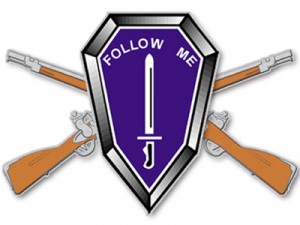
Infantry Officer Basic Leadership Course opens to women this fall. The first Rangerettes will do IOBLC first.
…that’s going to open to Rangerettes (note the new Category, which has been applied to all the stories since we initially broke this). Indeed, it never was just this school, because the focus of GEN Odierno and the suits for whom he steps and fetches has been on a bigger prize: combat assignments, specifically infantry combat assignments. (It’s puzzling why people with combat infantry experience would think it’s such a prize… oh, wait, we’re talking about General Odierno, SecDef Panetta, and whatever empty suit is Secretary of the Army… they’re on the outside looking in, combat-infantry-wise).
In any event, in the initial phone call from GEN Odierno to MG Brown, the commander at Ft Benning, which we’ve mentioned before (in relation to GEN Odierno’s playing catch up with the USMC), MG Brown was given the following instructions, and the opportunity to say, “yes, sir” and nothing else — which opportunity he availed himself of. It’s not like one gets to be a general through courage these days, after all.
- The Army can’t defend the current standards — any of them — at the Maneuver Center of Excellence. (Maybe it could have done when it was The Infantry School. But that ship has sailed).
- Such standards as there are can’t be reconciled with any operational requirement. (Maybe someone could ask combat-vet Rangers, but being a general means never having to ask for advice).
- The women-in-combat exclusion is over; while it’s still the law, the DOD and the Army are going around it baed on their executive authority. (Maybe Congress could stop this usurpation of its authority, but it is politically fragmented and won’t be able to resist such a coup).
- It’s important to get the change locked in and irreversible in case the executive changes hands in November. (Maybe the new regime won’t be enthusiastic about making the Army a sociology experiment in general, or women in combat assignments in particular, so women must be in the Infantry officer pipeline with a promise of Infantry assignments and commands by the fall).
Almost immediately lower-ranking generals and colonels went to work on the implementation. Here’s some of what they’ve worked out:
- The initial group will be a hand-selected pilot class.
- They will all be West Pointers from the Class of 2012.
- They will attend the Infantry Basic Officers’ Leadership Course and Ranger School.
- And they will pass. While the mask the public sees will say “there has been no change in the standards,” these are the first Ranger School students in the sixty-plus-year history of the school who start off knowing that whatever they do, they can’t fail. If they stumble, the suits and stars will be there to catch them, and to crush anyone who made note of it.
One of the most important decisions still to be made is whether the pilot-class women will be branched Infantry or not. To civilians reading this, officers have a branch of assignment that they normally serve in from initial entry to the end of their careers (because there is more need for combat arms officers in the lower ranks, at the 8 year point there is a mass massacre of combat arms officers, who have the choice of taking an involuntary reassignment to a support (like MI or MP) or service support (like QM or OD) branches, going to the Reserves or Guard if they can find a slot, getting out completely, or (in the case of officers with enlisted time) revert to enlisted status, with the added insult of a lower grade than they had before commissioning. So, unless he wins the 8-year no-prize, an Infantry officer can expect mostly Infantry duty and commands at all grades, an Artillery officer will spend his career with the big guns, etc. There are some exceptions, but mostly an officer stays in the branch he or she first joins.
So, to put women through IOBLC while they are commissioned in another branch, as an experiment, is a half step, and to commission women as Infantry officers is the full step. The brass will take the biggest step they can get away with.
If the brass hats think they can get away with it, these young officers will go to IOBLC and be made Infantry officers in a glare of publicity. If there’s resistance, the anointed few will first complete their initial officers’ basic course in another branch, and then enter the special pipeline, doing as second officers’ basic course: Infantry. After IOBLC, the ladies, their horse-holders and path-sweepers, and their media entourage will move on to the Warrior Training Center for some Ranger-school prep and a couple more shiny badges) and then Ranger School.
One thing that has not been taken into account, because this is all political and all about the girls’ careers, is whether this enhances the combat effectiveness of the Infantry. If you do not know what Infantry does, here are two ways to learn.
- Watch the first 20 minutes of the movie Saving Private Ryan, which shows a somewhat sanitized (!) version of what happened on the right (Western) flank of Omaha Beach on June 6, 1944. Bear in mind that the first units landed at about 0630, and the breakout depicted in the movie happened at several places on the beach at about 1400, so Mr Spielberg has compressed events enormously to make his narrative flow. But watch this, and ask which of the women you know would have made that go any better, and how a unit with 10 to 30 percent women would have done that day? (For extra credit, write your comment in German, which we’d probably all be speaking now).
- Read the official report on the Battle of Wanat, and watch Sebastian Junger’s documentary, Restrepo, in case you thought it got easy in the last sixty years. Short answer — not yet. Ask yourself the same question: what specific woman would have helped?
Do you favor or oppose this idea? And how do you make your opinion heard? Pro or con, the best way to put your opinion forward is to call the only institution that can stop it, and that’s true whether you think it’s a bad idea or a good one. That institution is Congress and you get the best bang for your buck by calling, not emailing and especially not faxing (nobody reads the spam faxes that professional fundraisers want you to pay them to send).
You have two Senators and one Representative. Whether or not you know who they are (you should! If not, shame on you), you can reach them through the U.S. Capitol Switchboard at (202) 224-3121. Ask for them by name if you know it, if not, the operators can still help you.

Kevin was a former Special Forces weapons man (MOS 18B, before the 18 series, 11B with Skill Qualification Indicator of S). His focus was on weapons: their history, effects and employment. He started WeaponsMan.com in 2011 and operated it until he passed away in 2017. His work is being preserved here at the request of his family.


